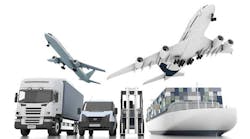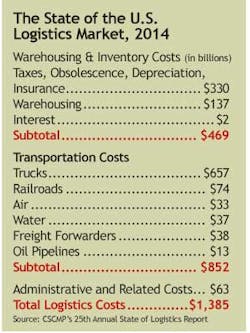From a logistics point of view, U.S. manufacturers have spent the past year doing a lot of waiting: waiting for the economy to improve, waiting for pickups and deliveries at their docks, waiting for the government to approve funding for federal highway programs, waiting for the sun to come out. Indeed, the various storms of Winter 2014 have been blamed for just about every negative earnings report, despite the fact that holiday retail sales were already off before the worst of the storms even hit.
As Jonathan Starks, director of transportation analysis with transportation forecasting firm FTR, explains, the severe winter weather "put a significant cramp on both transport capacity and on production days for much of the U.S." While the impact of the storm was expected to be short-lived, its memory lingers on, as it highlighted how tight the capacity situation has been and continues to be for both trucking and rail.

Overall, U.S. companies spent $1.39 trillion on business logistics in 2013, a relatively modest increase of 2.3%, or $31 billion. That total represents 8.2% of the U.S. gross domestic product. Warehousing costs were up 5.6%, while transportation costs were up 2.0%. That breaks down to trucking being up 1.6%, rail up 4.9%, water carriers up 4.5%, and air cargo was flat for the year.
The silver lining to the cloudy logistics environment is that Wilson expects 2014 to turn out to be a banner year. "The performance of the overall economy has not been stellar in 2014, but freight continues to gain momentum and accelerate," she says.
Although the bad weather contributed to a substantial drop in business inventories, that's not necessarily a bad thing. "It's a negative factor for GDP, but an overall positive for the economy," Wilson points out.
At the year's midpoint, then, Wilson believes that "freight will grow moderately for the rest of the year, and the economy should follow suit."
Popular Sponsored Recommendations
Popular Sponsored Recommendations
Voice your opinion!
Voice your opinion!
To join the conversation, and become an exclusive member of IndustryWeek, create an account today!
Members Only Content
Members Only Content
Members Only Content
Sponsored
Sponsored




